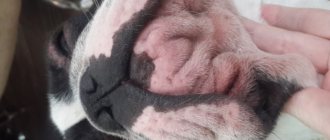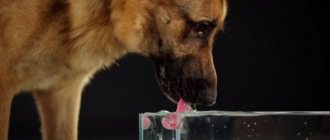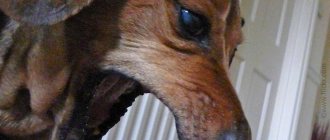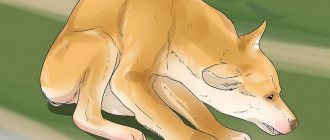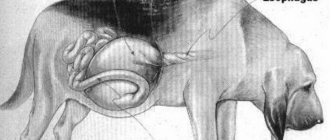A dog's nosebleed is a more than serious clinical sign that usually causes serious panic among owners. Indeed, it is generally accepted that dogs are simply not capable of suffering from this symptom, but this is not the case. There are many diseases and other factors that can cause nosebleeds in a pet. This could be a simple injury to the nose, a foreign body entering the sinuses, or a serious hereditary disease. Only a veterinarian can accurately determine this after conducting a whole range of necessary tests.
Blood from a dog's nose can be released in different ways, either in a constant flow or in small drops (dripping or splashing when sneezing).
Of course, owners are not able to immediately guess what caused the bleeding, much less cure the animal. If this symptom appears in your pet, the only thing you can and should do is give him first aid and take him to the hospital.
Main reasons
The most common reasons why dogs have nosebleeds are:
- renal failure, which provokes an increase in blood pressure;
- systemic hypertension (increased blood pressure due to cardiovascular pathologies);
- poisoning by rat poisons;
- injuries in the head and muzzle itself, when there is a violation of the integrity of the blood vessels in the nasal cavity;
- various malignant tumors in the nose (glandular cancer, various sarcomas);
- Cushing's syndrome (a very common cause of nosebleeds in dogs due to endocrine disorders - excessive production of the hormone cortisol by the adrenal glands) or hyperfunction of the thyroid gland;
- polycythemia (an abnormal rise in the level of red blood cells - red blood cells) and vasculitis (inflammation of blood vessels in the nasal cavity);
- blunt blows directly to the nose (swelling almost always forms around, and especially under the eye sockets);
- any infectious inflammation caused not only by bacteria, but also by viruses and fungi;
- internal damage to the mucous membrane due to foreign objects entering the nose;
- any pathologies in the oral cavity accompanied by bleeding;
- genetic diseases accompanied by disorders of blood clotting, characteristic only of some breeds: thrombopathy in basset hounds; thrombasthenia in Otterhounds; hemophilia B in St. Bernards and Yure Terriers; von Willebrand coagulopathy in Shelties, Dobermans, Chesapeake Bay Retrievers, Airedales and Scotch Terriers; hemophilia A in Germans;
- heat/sunstroke from being in a stuffy, unventilated room or in the open sun for a long time.
Coagulopathy
Disorders caused by blood clotting may also explain why a dog is bleeding through the nose. In order for coagulation to take place, a number of elements must be present in the blood. When one of them is missing, spontaneous hemorrhages may occur.
Sometimes this deficiency can be caused by poisoning. For example, some rodenticides prevent a dog's body from making vitamin K.
, a necessary substance for proper coagulation. Its deficiency causes the dog to experience nosebleeds, rectal bleeding, vomiting blood, bruising, etc. These cases are veterinary emergencies.
Sometimes these bleeding disorders are inherited, as in the case of von Willebrand disease. In this condition, which can affect both males and females, there is insufficient functioning of platelets, which can manifest with nosebleeds and gums or blood in feces and urine
, although often the hemorrhages are not noticeable and, in addition, they decrease with age.
Hemophilia also affects clotting factors, but the disease only affects males. There are other coagulation deficiencies, but they are less common. Diagnosis of these conditions is made using specific blood tests. If severe bleeding occurs, blood transfusions will be required.
Finally, there is a hemorrhagic disorder, not hereditary but acquired, called disseminated intravascular coagulation
(DIC), which appears in certain situations such as infections, heat stroke, shock, etc. and this manifests itself in the form of bleeding from the nose, buccal, gastrointestinal tract, etc., which is an extremely serious disorder , which usually causes the death of the dog.
This article is for informational purposes only, we are not in a position to prescribe veterinary procedures or make any diagnoses. We invite you to take your pet to the veterinarian in case of any conditions or discomfort.
This problem also affects pets. After all, they also have problems with blood vessels. However, there are many other causes of nosebleeds in dogs. We will learn about them, as well as the actions of the owners in such situations.
When there is more than just bleeding
When your dog's nose is bleeding and any additional symptoms are observed, it is recommended to take the animal to the hospital as quickly as possible, because... This phenomenon may pose a potential threat to life:
- red urine or tarry stool due to chronic nosebleeds (most likely nasal discharge is just the tip of the iceberg, and most of the blood goes inside);
- blood when sneezing (a sign that the process in the nasal cavity is ongoing without stopping and by sneezing the animal is trying to clear its breath; it is also a sign of the presence of blood in the oral cavity - often accompanies hemophilia);
- the mucous membranes in the head area begin to turn pale - the eye conjunctiva, gums, lips, tongue (a sign of serious blood loss and anemia);
- the dog is breathing heavily, almost unconscious, does not respond to the name (severe blood loss or heat/sunstroke is possible);
- the mucous membranes have become yellowish or intensely jaundiced (a sign of jaundice due to liver dysfunction - most often observed in blood parasitic diseases);
- severe swelling of the muzzle, obvious pain when the owner tries to touch it, hemorrhage under the skin (the swelling is soft, the hole does not recover immediately from pressure) /
How to stop nosebleeds in your pet
Therapeutic measures depend on the root cause of the problem. If infection occurs, the bleeding is stopped with antibiotics. Surgical cauterization is used in cases where the nasal mucosa is weak and the dog bleeds regularly.
When the cause of the problem is a foreign body in the nose, it is carefully removed. But when a tumor is detected in this organ, a biopsy is performed, surgery is used, and sometimes chemotherapy is used. As you can see, the methods of stopping bleeding in clinical settings are different and depend on the factor that provoked it.
Both at home and in hospitals, they practice applying cold - it narrows the capillaries, and soon the blood thromboses. Some specialists administer adrenaline in such situations. It constricts peripheral blood vessels.
As for prognoses, they depend, again, on the cause of the bleeding. If this is a common injury, the presence of a foreign body in the nose, then there is no need to worry about the dog’s condition - everything will pass. And when it comes to malignant neoplasms and genetic diseases, the prognosis is often unfavorable.
Nosebleeds in pets can occur for a variety of reasons. This is not uncommon, and therefore it is necessary to know what caused such an unpleasant process, because the general condition of the dog may depend on it. It tends to manifest itself both during sneezing in the form of a certain number of drops of blood, and without provocative processes, that is, a streamy regular discharge from the nostrils of a dog that is in a static position, sometimes even during sleep.
First aid that the owner can provide
Without knowing the cause of the pathology, it is very difficult to fully help! The main tasks that every dog owner faces:
- Stop bleeding if possible.
- Remember as much information as possible about the circumstances under which the bleeding began and its nature, as well as the general condition of the animal at that time and possible changes.
- Take your pet to a veterinary clinic for full medical care.
First aid procedure:
Calm yourself and calm the animal
An increased level of excitability will lead to the process intensifying due to a jump in blood pressure due to nervousness. You need to calm the animal with words and stroking - no sedatives should be given, so as not to subsequently blur the diagnostic picture for the veterinarian.
Cold on the bridge of the nose
Place something cold (frozen food, ice, snow) in the nose area, wrapped in a bag and a thin towel. If the animal is restless, you will have to ask someone for help to additionally hold its head. Do everything carefully, without pressing too hard. Cold causes blood vessels to constrict and may help stop bleeding.
Conduct a self-examination
If you manage to stop the bleeding, you need to carefully wash the dog’s face or wipe it with wet wipes in order to examine it yourself. It is possible that you can still help with something - treat small wounds (if any), carefully remove splinters or a foreign object from the nose. You need to act only if your own actions are beyond doubt. If you doubt that you can handle it, don’t do anything else, take your pet to the veterinarian!
What should you do if your dog has a nosebleed?
It may happen that a dog’s severe nosebleed starts at home, at a time when the owner least expects it. In order to know what exactly needs to be done in such a situation, you need to carefully study all the recommendations below.
- The first thing the dog owner should do is try to calm the animal, since nervous excitement leads to increased blood pressure and, as a result, increased bleeding.
- Under no circumstances should you give your pet any sedatives (unless, of course, you have previously discussed this with a specialist).
- Try to convince your household that they also need to calm down and try to remain quiet. The fact is that the pet is inclined to feel the mood and transfer it to itself, and excess excitement, as already mentioned, cannot lead to anything good.
- Then you need to put something cold on the back of the animal's nose (a small bag of ice is ideal). This is the most effective way to reduce or stop blood flowing from your dog's nose, as cold causes blood vessels to constrict.
- If you have made every effort to stabilize the situation, and the bleeding remains as severe or the dog has difficulty breathing, you must immediately take the animal to the clinic or call a veterinary ambulance.
If you have already called the veterinarian or are on the way to the hospital, you should:
- Be as calm as possible and try to concentrate and remember certain details that can significantly speed up the diagnostic process and, accordingly, speed up therapy.
- Make a list of medications you have given your pet recently.
- Think about whether the dog could have been poisoned by poison against mice and rats or eaten a rodent that had already eaten poison.
- Examine the dog's head: look for any imbalances or changes in proportions. You may notice swelling of the bridge of the nose, inflammation of the third eyelid, different eye sizes, tears, injuries, or a change in the color of the epidermis covering the bridge of the nose. If you notice any of the above changes, you should definitely tell your veterinarian about it.
- Try to remember if your pet took part in any active games with other dogs and if you let him out of your sight. There is a possibility that the nose was damaged during the fight.
- Think about it: did you walk your pet in a place where there were a lot of plants with hard stems? They could also cause damage.
- Remember if the dog sneezed shortly before the bleeding and if it rubbed its nose with its paws.
- Open your dog's mouth wide and carefully inspect the mouth for bleeding, pale mucous membranes or conjunctiva. If the mucous membrane turns very white, this means that the animal has lost a lot of blood and needs immediate hospitalization. If there is a queue at the clinic, tell the staff about it - this case should be considered first.
- Consider whether your dog has recently had black stools or vomited blood. These symptoms indicate internal (intestinal or stomach) bleeding. However, remember, you should only worry if the above signs occurred before the dog started bleeding from the nose. Otherwise, they can only be a consequence of the animal swallowing a certain amount of blood.
- Examine your pet's body for swelling or bleeding.
If, following the advice described above, you discover something, you should definitely tell your doctor about it.
Determining the cause (diagnosis)
On the way to the veterinarian, you should be prepared with a little medical information (a brief medical history) to help make a diagnosis. It is enough to answer the following questions:
- Has the dog been given any medications in the last few days? Which?
- Is there rat poison in the house? Is there a chance that the pet has eaten it?
- Were there active, outdoor games on the eve of the event? Maybe the animal got into a fight with its fellows?
- Injuries from sharp, spinous plants?
- Are the mucous membranes pale? (dogs with blanching mucous membranes should be accepted without a queue - there is a risk of death from blood loss)
- Sneezing – yes/no, how often?
- Were there any signs of internal bleeding (entering the stomach) - black spotting stool?
- Whether hemorrhages or subcutaneous hemorrhages were noticed.
After the survey and examination, the veterinarian may prescribe and conduct additional examinations:
- urine and blood tests (full, including for infections and genetic pathologies), serological tests;
- rhinoscopy;
- X-ray of the nasal passages and jaws;
- X-ray of the chest cavity to determine the presence of internal bleeding;
- endoscopy with collection of mucous samples for biopsy (in extreme cases);
- diagnostic surgery.
What to do?
It is quite difficult to determine the cause of bleeding by eye. This can be done by contacting a specialist and analyzing a number of associated symptoms. However, the first thing the owner must do is try to stop the bleeding. Here is an action algorithm that will help you not get confused in an extreme situation:
- Calm down.
Your panic, as you know, is immediately transmitted to the animal, and excitement increases the pet’s blood pressure. And, as a result, bleeding increases, despite the measures taken. - Cool.
A cold compress on the bridge of the nose will constrict the blood vessels and stop the bleeding. In order for the effect of the compress to be stronger, try to fix the animal motionless and hold it for several minutes, without pressing the ice too hard to the head. - Inspect.
Now that first aid has been provided, it’s time to conduct a preliminary examination of the dog. To begin, thoroughly wipe your face with a damp cloth, getting rid of traces of blood, and inspect the bridge of your nose and nasal passages for swelling, damage, and the presence of foreign bodies. If it is clear what the problem is, you can alleviate the dog’s condition yourself, for example, by treating a wound or removing a splinter from the nose. But you need to do this only if you are completely confident in yourself and the correctness of your actions. If you have the slightest doubt, entrust the treatment to a specialist. - Do not touch the crusts.
Very often, crusts form in the dog’s nose, preventing free breathing. Do not be afraid that your pet experiences discomfort when breathing with its mouth - this process is quite natural for animals. Small scabs of dried blood not only prevent the dog from breathing, but also serve as a natural blockage to the damaged vessel and stop the bleeding. - Take him to the clinic.
Even if the bleeding has stopped and your pet’s general condition is not suspicious, be sure to take him to the vet. Often, bleeding is a symptom of quite serious diseases, which can only be diagnosed by a specialist.
Therapeutic prescriptions of the veterinarian
First of all, the specialist will stop bleeding that was not stopped by the owner himself.
Hemostatic drugs:
- Hydrogen peroxide or Antipyrine 20% for soaking cotton-gauze swabs for insertion into the nasal passages.
- Adrenaline in a dosage of 0.2-0.5 ml (1:10000) subcutaneously (not used for pulmonary injuries, since adrenaline in the lungs additionally dilates the blood vessels) or add up to 5 drops of a solution to 5 ml of novocaine and instill into the nasal moves.
- Calcium gluconate/chloride 10% - slowly into a vein 5-15 ml, depending on the intensity of bleeding and the size of the animal.
- Ephedrine 2% is administered subcutaneously or intramuscularly with caution up to 10-50 mg under the strict supervision of a specialist. Do not use in puppy dogs or for hypertension. Effective for long-term rhinitis with increased bleeding.
- Vikasol - injected into the muscle at a dose of 1-2 mg/kg of body weight (1 ml of vitamin K solution contains 10 mg of the active substance), after warming the ampoule in the palms to body temperature.
- Desmopressin – 4 units is dissolved in 20 ml of isotonic sodium chloride and administered very slowly intravenously (up to 10 minutes). Used for von Willebrand disease.
- Transfusion of Cryoprecipitate for extensive blood loss due to genetic diseases accompanied by nosebleeds. On the first day it is infused every 3-4 hours, then after 6 hours and after another 12 hours.
Additional symptoms
Most often, nosebleeds appear suddenly, and owners are at a loss, not knowing what is causing the bleeding. However, if you carefully observe your pet, you will find several other, obvious or hidden signs that will help greatly facilitate subsequent diagnosis. What should you pay attention to during a self-examination?
- Asymmetry and deformation of the animal's muzzle.
Possible bruising and swelling indicate a traumatic cause of bleeding. In this case, the doctor should pay attention to the presence of other injuries - possible fractures or hematomas. - Paleness of the mucous membranes.
Pale color of the conjunctiva of the eye and mucous membranes of the mouth may be a sign of large blood loss caused by internal bleeding. - Vomiting blood and black stools.
These symptoms also indicate damage to internal organs and excessive internal bleeding. - Continuous sneezing.
With the help of this physiological process, the animal tries to clear the nasal passages of blood and facilitate breathing. Most often, this indicates that the bleeding has been going on for a long time without stopping and not only the nose, but also the dog’s mouth is full of blood. This often happens with hemophilia or other pathologies in which the blood clotting process is slowed down. - Heavy breathing and loss of consciousness.
If this happens in the warm season or in a stuffy room, most likely we are dealing with heat stroke or overheating in the sun. - Restlessness, attempts to rub his face with his paws.
This is a sign of a foreign body in the nose or mouth. Carefully examine your pet by looking into the nasal passages with a flashlight. If the foreign body is far away, do not try to pull it out yourself - you may drive it even deeper. The veterinarian, using special tools, can easily remove both the splinter and the foreign object. - Swelling of the skin.
If, when pressing on the dog’s paw or side, the finger hole does not straighten out immediately, we can talk about swelling of the soft tissues, indicating problems with the kidneys.
Treatment depending on diagnosis
- How to treat a dog with blood incoagulability? Therapy is carried out only in a hospital setting with special blood replacement drugs, stimulating the work of injected platelets. Owners must be informed about all the risks of treatment and the course of the disease, including death.
- If you need to remove a foreign body located deep in the nose, surgical intervention is performed under general or local anesthesia. Also, surgical access may be necessary if it is not possible to rinse the dog’s nasal passages without causing additional injury.
- Fungal rhinitis is treated by injecting antifungal drugs into the nose, by insulating powdery substances using tubes, or by irrigating the mucous membrane with aerosols.
- Chemotherapy for cancerous lesions and surgery to remove tumors.
- Transfusion of blood or pure red blood cells for large blood losses.
- Hormonal therapy for endocrine pathologies.
- Antibiotic therapy depending on the type of infection detected.
- In case of renal failure, in parallel with treatment, it is necessary to follow a diet.
- Therapy aimed at lowering blood pressure (if persistent hypertension is recorded).
In case of repeated cases of bleeding, regardless of the cause, after courses of treatment, animals must undergo subsequent regular monitoring of hemoglobin levels, erythrocyte and platelet composition of the blood, as well as blood pressure.
Methods and methods of treatment
In a situation where a dog is bleeding from the nose without stopping, the veterinarian takes measures to stop it, and only after that makes a diagnosis and prescribes treatment. Depending on the complexity of the detected disease, the dog breeder may be offered inpatient or outpatient treatment. In severe cases, surgery is indicated.
Thus, coagulopathy is treated exclusively in a hospital setting, while diseases associated with blood vessels are treated at home. To treat rhinitis, use a solution of Povidone or Clotrimazole. Cancerous tumors are treated with chemotherapy, and bacterial infections with a course of antibiotics.
In order for the treatment to benefit the animal and promote a speedy recovery, it is necessary:
- limit the dog’s movements (put him on a leash, in a small enclosure)
- give the animal only those medications prescribed by the veterinarian;
- leave the dog alone, paying attention to it only when taking medicine and food (no games or sudden movements).
Treatment of animals is an individual process, therefore, if the nosebleed does not stop, you should not go to your neighbor, but call a veterinarian.
What's the forecast?
The prognosis is based on the cause of the nosebleed and the animal's health at the time of diagnosis. Your veterinarian will provide you with detailed diagnostic and treatment plans, as well as a prognosis based on your pet's condition.
The health of our four-legged pets often worries us no less than our own, which is why we perceive any problem with excitement and a desire to quickly remove the unpleasant symptom. One such reason that worries owners is nosebleeds - a situation when blood flows out of the animal's nasal passages or blood clots fly out.
How is it diagnosed?
First, the veterinarian will require a complete medical history from you. Useful information may be:
Once the medical history has been assessed, the veterinarian will perform a physical examination. Abnormalities the veterinarian will look for:
- Deformation or asymmetry of your pet's face
- Swelling of the nasal septum
- Third eyelid
- Prominence or sluggishness of one eye compared to the other.
- Redness of the eyes
- The appearance of bald skin around the nose
- Gums color, bad if they appear pale

